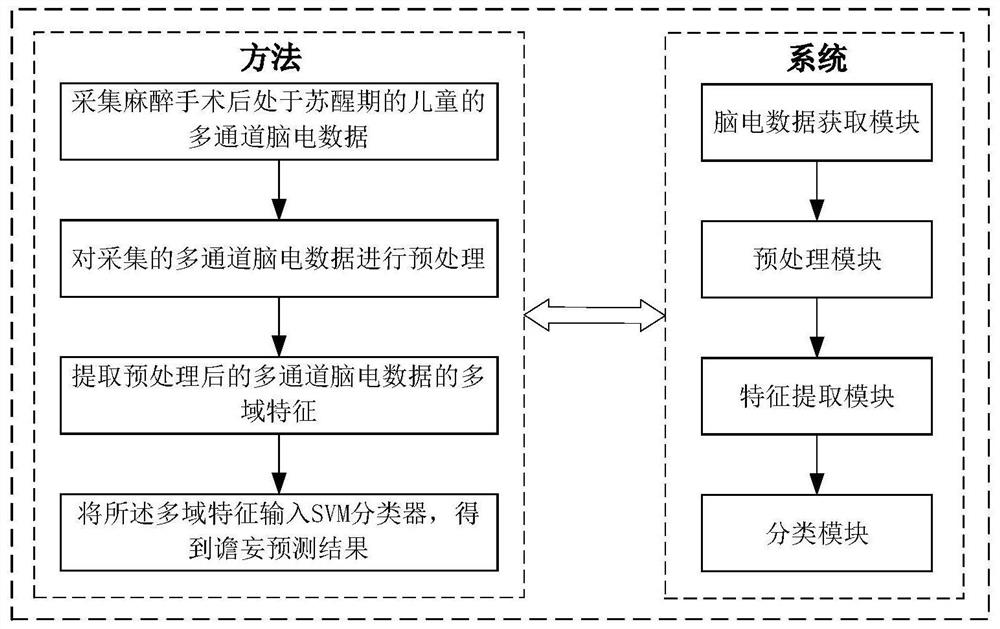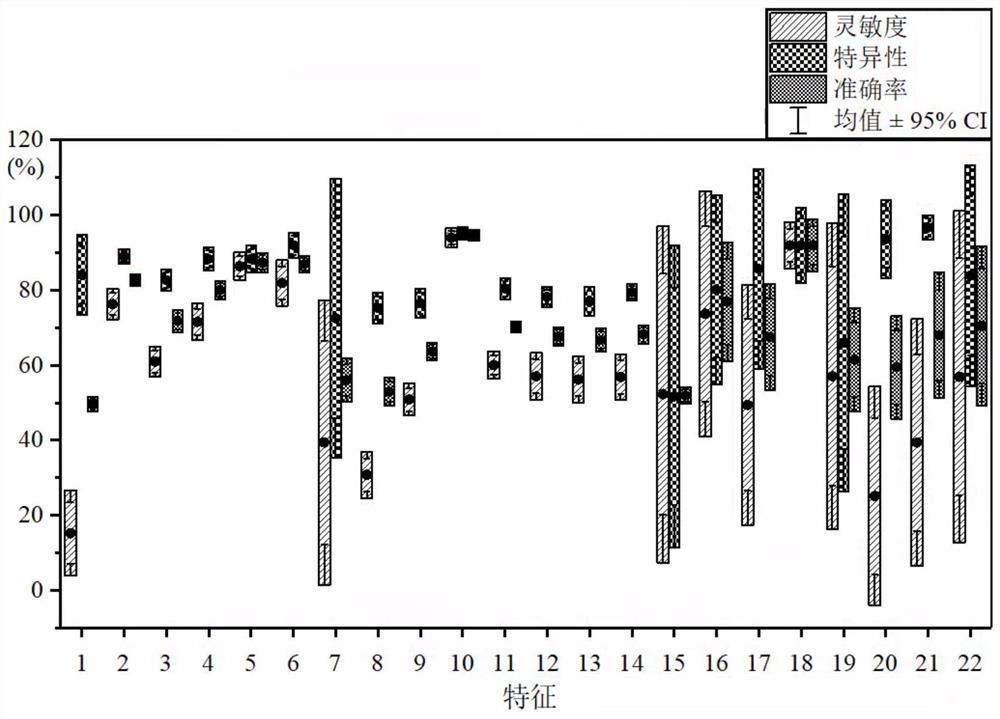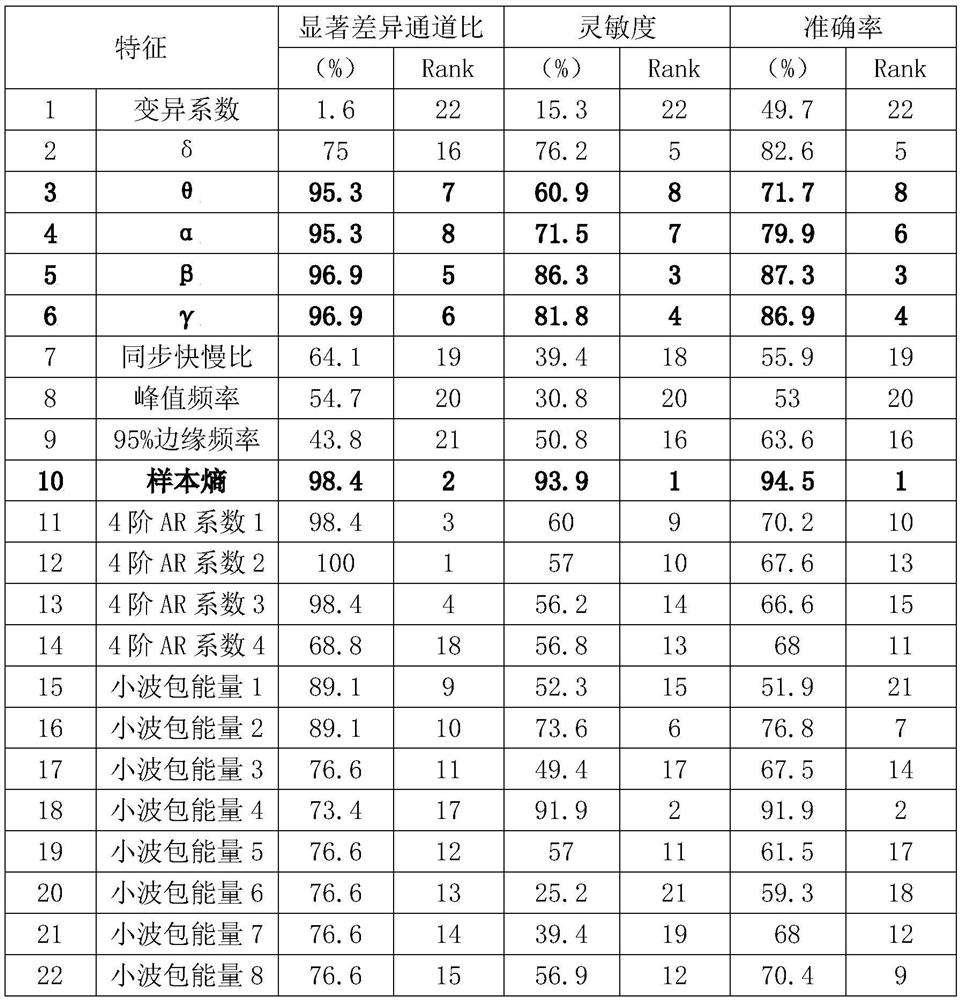Child delirium prediction method based on electroencephalogram signals and system thereof
A prediction method and technology of EEG signals, which are used in diagnostic recording/measurement, medical science, sensors, etc., can solve the problems of unpredictable delirium and low detection accuracy, and achieve the effect of excellent prediction performance.
- Summary
- Abstract
- Description
- Claims
- Application Information
AI Technical Summary
Problems solved by technology
Method used
Image
Examples
Embodiment 1
[0051] Such as figure 1 As shown, a method for predicting delirium in children based on EEG signals, the specific processing steps are as follows:
[0052] Step 1: Collect multi-channel EEG data of children who are awake after anesthesia surgery;
[0053] Step 2: Preprocessing the collected multi-channel EEG data;
[0054] Step 3: Extracting multi-domain features of the preprocessed multi-channel EEG data;
[0055] Step 4: Input the multi-domain features into the SVM classifier to obtain the delirium prediction result, that is, whether or not there is delirium.
[0056] The preprocessing in the step 2 specifically includes the following steps:
[0057] Step 21: Downsampling the multi-channel EEG data to 1000 Hz;
[0058] Step 22: Eliminate the interference data in the multi-channel EEG data obtained in Step 21 through 0.5-45 Hz band-pass filtering to improve the signal-to-noise ratio;
[0059] Step 23: Correct the abnormal multi-channel EEG data after interference elimina...
Embodiment 2
[0065] This embodiment is a child delirium prediction system based on EEG signals, including:
[0066] The EEG data acquisition module is used to collect multi-channel EEG data of children in the awakening period after anesthesia surgery;
[0067] The preprocessing module is used to preprocess the EEG data obtained by the EEG data acquisition module;
[0068] The feature extraction module is used to extract the multi-domain features of the preprocessed EEG data;
[0069] The classification module is used to input the extracted multi-domain features into the SVM classifier to obtain prediction results.
[0070] The preprocessing module specifically includes:
[0071] A downsampling module, configured to downsample the multi-channel EEG data to 1000Hz;
[0072] Filtering module, for eliminating the interference data in the multi-channel EEG data obtained in step 21 through 0.5~45Hz bandpass filtering, and improving the signal-to-noise ratio;
[0073] The correction module is...
Embodiment 3
[0077] This embodiment provides the selection method of multi-domain features and kernel functions.
[0078] Step 1: Collect 64-channel EEG data of subjects during the postoperative recovery period in the anesthesia recovery room, with a sampling rate of 2048Hz; after the subject wakes up, two professional medical staff judge whether the subject has delirium or not according to the PAED scale. The label was recorded as 1, and the non-delirium label was recorded as 0; finally, 21 subjects were included, including 11 delirium subjects and 10 non-delirium subjects.
[0079] Step 2: Preprocessing the EEG data: down-sampling the EEG data to 1000 Hz; eliminating interference through 0.5-45 Hz band-pass filtering and improving the signal-to-noise ratio; correcting abnormal EEG data by interpolation Electrical channels, specifically, use the average value of adjacent channels to replace abnormal EEG channels; segment EEG signal segments based on a sliding window with a fixed window le...
PUM
 Login to View More
Login to View More Abstract
Description
Claims
Application Information
 Login to View More
Login to View More - R&D
- Intellectual Property
- Life Sciences
- Materials
- Tech Scout
- Unparalleled Data Quality
- Higher Quality Content
- 60% Fewer Hallucinations
Browse by: Latest US Patents, China's latest patents, Technical Efficacy Thesaurus, Application Domain, Technology Topic, Popular Technical Reports.
© 2025 PatSnap. All rights reserved.Legal|Privacy policy|Modern Slavery Act Transparency Statement|Sitemap|About US| Contact US: help@patsnap.com



